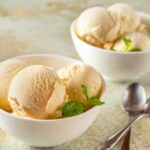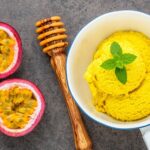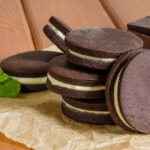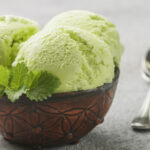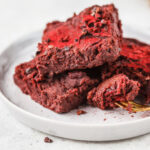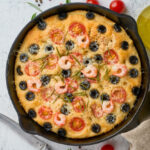Looking for a special treat that also brings some health benefits? Find out why cacao nibs is a good option and get some great cacao nibs recipes to kick start your healthier snacking.
Cacao nibs are widely used in cooking and to make high-quality dark chocolate. Read on to find out more about these healthy, perfectly keto, and gluten-free recipes.
Contents
What is the cocoa bean?
Scientific name: Theobroma cacao
Other names: Raw Cocoa, Cocoa seeds, cacao nibs. The cocoa tree is also closely related to the cupuaçu fruit which is from the same family..
Cocoa beans, or raw cacao(cacao usually refers to a high-quality more natural organic version of cocoa produced in small farms in limited quantities also known as ceremonial cacao).
They are the seeds of the cacao tree fruit of the Theobroma family, it’s well known for being used in the manufacture of chocolate. They are found in the center of the cocoa fruit, which contains from 16 to 60 seeds, placed on 5 rows similar to a box of eggs.
Cultivated in many countries with a warm and humid climates, the cocoa tree yields about a hundred fruits per year, which themselves contain about forty beans, wrapped in a white pulp. Once extracted, they are fermented and then dried to remove the pulp, attenuate the acidity and develop the aromas.
Fresh cocoa beans are quite sticky because they are covered with a white pulp, and sweet-tart mucilage consisting of 80% water, 15% glucose, and 5% pectin.
Once harvested, the husks are broken by hand, the seeds are sorted and cleaned, then fermented for 5-6 days, which has the effect of increasing tenfold the active nutrients and enzymes, as well as reducing bitterness. They are then dried slowly in the sun for 1 to 4 weeks.
Since raw cocoa beans are not roasted, they retain their chocolatey and rather bitter flavor, a powerful but refined aroma, as well as all their nutritional and therapeutic properties.
Cocoa Beans Uses For Consumption
Cocoa Beans undergo 2 other transformations for the manufacture of cocoa powder and chocolate bars: roasting and grinding.
To roast them, they are heated at 150°C for about 25 min, which develops all the wonderful aromas of cocoa. The beans are then ground to form a thick liquid cocoa paste from which the fat (Cocoa Butter) is extracted.
The dark chocolate we know and love today consists of a mixture of cocoa paste, cocoa butter, and sugar. The proportions vary depending on the desired chocolate: dark chocolate 99%, 90%, 80%, 70%, etc. the percentage indicates the amount of cocoa paste.
Other ingredients are also added to make different types of chocolate: milk, spices, Madagascar bourbon vanilla, oils, hazelnuts, almonds, fruits, etc.
During this stage, the fat is removed from the beans, it is called Cocoa Butter, which is mostly used in the food and pharmaceutical cosmetic industry.
Then the roasted cocoa beans are ground to a powder, kept as is or chopped(crushed) to pieces and will give us the so-called Cacao nibs.
Some producers remove completely the white pulp that covers the beans, while others do not. This in no way changes the quality of the product, but it results in some differences:
– the carefully cleaned cocoa beans are purplish red, and their taste is slightly sweeter
– the others that are not cleaned from the pulp are almond brown. Their taste is rawer, slightly bitter.

If the seeds are dried for too long, they develop a purple or black color. If they are not dried enough, they are clear, but don’t last long and become rancid fairly quickly and get mold.
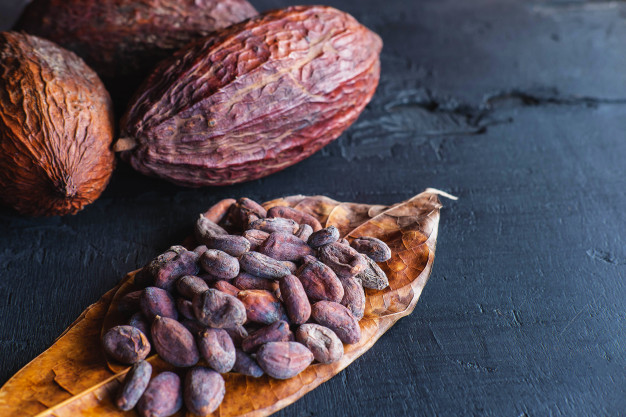
Raw Cacao Beans
There are 10 types of cocoa beans:
- Criollo cacao beans
- Amelonado
- Nacional
- Contamana
- Curaray
- Cacao guiana
- Iquitos
- Maranon
- Nanay
- Purus
10 Easy Cacao Nibs Recipes
Try any of these easy cacao nib recipes which you can make at home and you won’t regret it.
Cocoa beans give a special flavor to your dishes by bringing a sweet side and bitterness at the same time. It is possible to integrate the cocoa bean into refined cuisines or in a homemade recipe which is very easy to make. Here are some recipes with cocoa beans.
So, how to use cocoa beans in cooking? Most times you’ll need to crush or grind them before using them in your recipes.
Crispy hazelnut tuile with cacao nibs recipe
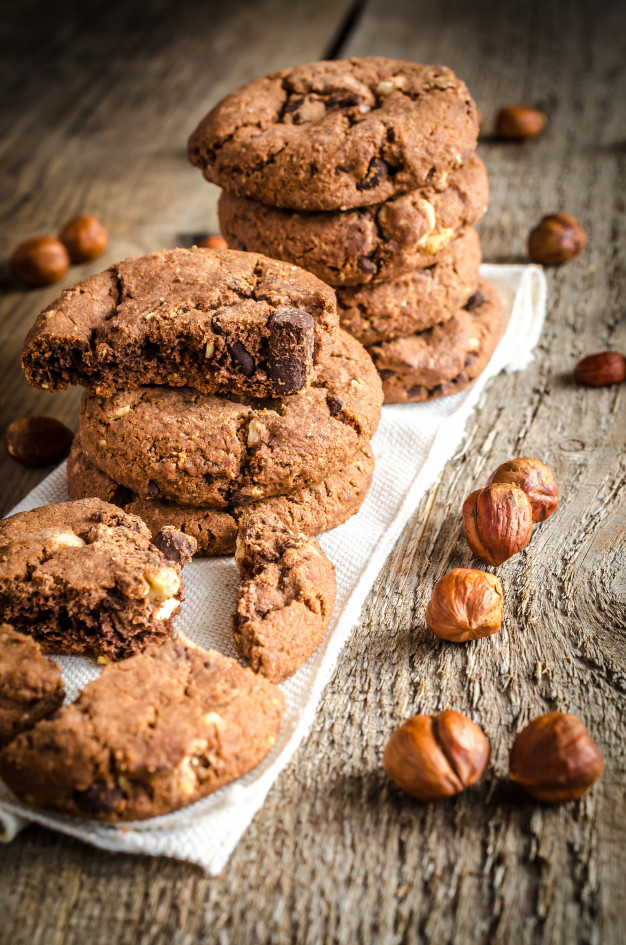
Ingredients
- 1 egg white
- 30 g. sugar
- 15 g. flour
- 15 g. butter
- 15 g hazelnut powder
- 4 to 5 cocoa beans.
Method
- Crush the cocoa beans in a pestle.
- Mix egg white, butter, flour, and cocoa beans.
- Then spread the dough on a baking sheet.
- Bake for 4 minutes at 180°. Repeat until the dough runs out.
Shortbread Cookies With Cacao Nibs
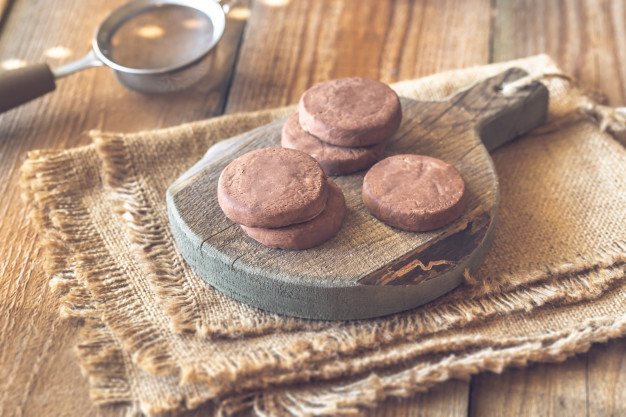
Ingredients
- 320 g. of flour
- 25 g. of almond powder
- ¼ g. of salt
- 1g. of yeast
- 250 ml of milk
- 70 grams of coconut powder
- 70 g. of cocoa beans.
Method
- Mix the flour, almond powder, salt, and yeast.
- Add the liquids and add cocoa beans.
- Stir well.
- Lay out a small pile on a baking sheet.
- Cook for 20 minutes at 350 degrees F | 175 degrees C (thermostat 6).
Confit of Duck Legs With Cocoa Bean Cassoulet Sauce
Ingredients
- 4 farmer duck thighs
- 400 g of pre-cooked small beans
- 200 ml of sour cream
- 6 to 7 cocoa beans
- 1 tsp cinnamon coffee
- 1 tsp coriander.
Method
- Put the duck legs directly to return to a frying pan without fat.
- When the thighs are well browned, discard the excess fat.
- Then add the sour cream.
- Add the coriander and cinnamon and salt and pepper to taste.
- Stir in the cocoa beans, dilute with broth and simmer for 50 minutes.
- Add the small beans 15 minutes before the end of cooking.
- Serve duck legs with cocoa sauce.
Tea Infused With Cacao Nibs
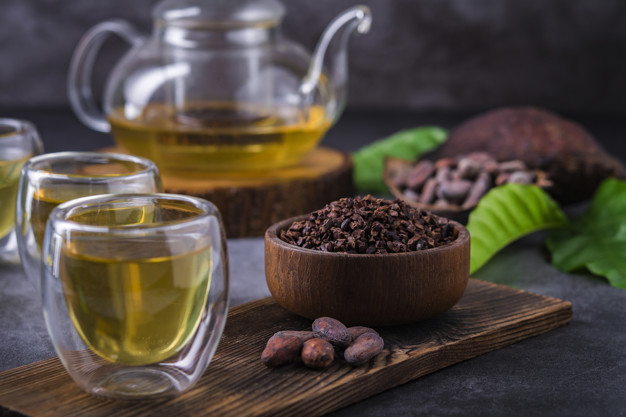
You can use cocoa beans in recipes for hot tea infusions. It’s best to use dried cocoa beans. Thus, the skin/shells of the cocoa beans are used to infuse them in hot water.
Cacao Nibs Spreading Paste
The whole cocoa bean soaked and softened in hot water can be used to be mixed with hazelnut butter and prunes to make a wonderful cacao spread paste.
The uses of cocoa beans are numerous and it is possible to make sauces that you can add to meats or other sweet and salty dishes. Cocoa beans are excellent for integrating into pastries too.
Truffles With Cacao Nibs
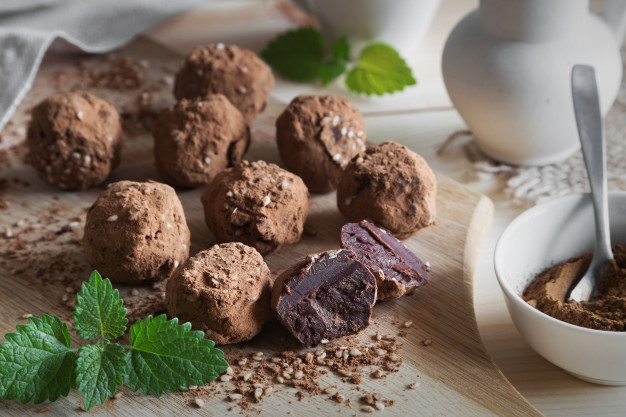
prep:20 min
time: 4 min
difficulty: easy
Ingredients
Number of portions:4
For 12 to 15 truffles :
- 12 to 15 whole raw cocoa beans
- 15 ml Cocoa Butter or coconut oil
- 30 ml of agave nectar or maple syrup
- 45 gr. raw cocoa powder + a little more to cover the truffles
Preparation
- Prepare the ganache by melting cocoa butter or coconut oil in a water bath over very soft heat.
- Add the agave nectar and 45 ml of cocoa powder and mix well.
- Once homogeneous, put in the fridge for about an hour, while the ganache is frozen.
- To shape the truffles, take a small spoonful of ganache and bury the cocoa bean in it.
- The Bean should be well covered with ganache.
- Roll the truffle into the cocoa powder.
It is better to keep these truffles in the fridge until they are served.
Cocoa Liquor From Cacao Nibs
This recipe is similar to my homemade baileys recipe so check it out.
Ingredients
- 200 ml of water
- 150 g brown sugar
- 3 tonka beans
- 3 vanilla pods
- 750 ml of alcohol
- 150 g bitter cocoa
Preparation
- Make syrup with water and sugar. For this let it boil for 10 minutes.
- Off the fire add vanilla pods, and pounded tonka beans. Let it cool.
- Then mix the cocoa intimately with alcohol; add this mix to the fragrant syrup. Mix well.
- Strain and bottle, leaving the vanilla pods.
Granola With Coconut And Cacao Nibs

(This was my first attempt at using the cacao nibs in a recipe when I first bought them and since then I’ve been using them quite regularly in all sorts of creative ways to enjoy them. For example look up the recipes above.)
A while ago, I found myself nose to nose, on the shelves of a health store, with cocoa beans. It had a good aroma of almonds and would tasted chocolatey, with lots of nutritional claims on it, good for my brain I guess.
So I put them in my basket and wisely waited for snack time to taste them. I felt a slight disappointment when I chew them up first: it is pure raw cocoa, with all the bitterness that goes with it, and then what?
Cacao nibs are nothing special at first: when you chew, they crunch in your teeth. They are hard(so be careful not to crush your teeth). Not delighted really, but I’m not giving up yet either- I knew well that I would find a way to cast a spell (cook) on them, sooner or later.
And Bingo: while searching on the net, I came across a recipe that would allow me to pass on both my crunchy cocoa beans and my bag of coconut chips that had not yet been finished in time.
The problem is that, as with all good recipes, it dramatically makes you want to buy back the ingredient you previously wanted to get rid of. Because granola is very, very addictive like this homemade granola or this paleo granola bars version (for me at least)– you have been warned!
Granola can be stored for 1 month in an airtight jar (it lasted 3 days).
Bourbon Vanilla Cookies With Cocoa Nibs

Ingredients
For fifteen cookies
- 220 g flour
- 80 g white sugar
- 80 g brown sugar
- 120 g soft butter
- 1 egg
- 1 cup baking powder
- 1 cup of Bourbon vanilla powder from Madagascar or in pods
- 1/4 cup salt
- 80 g of chocolate chips
- 1 cup roasted cocoa beans
Preparation
- First, preheat your oven to 180 °C.
- Mix the butter with the two sugars. Then add the egg and vanilla pod powder. Mix well.
- Then add the dry ingredients, flour, yeast, and salt. Mix until a homogeneous device is obtained, which easily peels off the bowl.
- Finally, add the chocolate chips as well as the beans that you will have burst to the size that suits you. Opt for fairly small pieces, to avoid saturating with bitterness at the tasting.
- Form balls using a tablespoon and place them on a baking sheet with baking paper. Lightly flatten the cookies before baking.
- Cooking takes about 10 minutes. The cookie must have an edge that cracks gently but the heart is always fluffy.
Note:
Did you know it was possible to eat this raw cookie dough? Yes! But for this, you just need to remove the yeast and Brown the flour for 5 minutes in a very hot oven, to destroy the bacteria!
Biscuit Cookies With Cacao Nibs

Biscuits with milk and cocoa beans
8 persons
Preparation time 30 min.
Cooking time15 min.
Ingredients
- 150 g of semi-complete wheat flour
- 50 g of chestnut flour
- 20 g of beer yeast in sequins
- 80 g butter
- 100 ml of milk
- 80 g of brown sugar
- 2 tablespoons of roasted cocoa beans
Preparation
- Mix wheat flour, chestnut flour, beer yeast in glitter, and 1 pinch of salt.
- Warm milk and butter, and add sugar. Stir until dissolved.
- Pour into the flour, mix quickly and form a ball. Cover with stretch film and let stand for at least 1 h in a cool place.
- Chop the cocoa beans with a large kitchen knife.
- Preheat the oven to 350°. Roll out the dough thinly enough on the floured worktop. Cut out the Cookies in the form of small butter.
- Store them on a baking sheet lined with parchment paper. Sprinkle them with chopped cocoa beans.
- Bake 12 to 15 minutes in the oven. Let the cookies cool for 15 minutes on a grate.
Tip: For kids! Use chopped chocolate and add a few shards of cocoa beans (in small quantities) so that they discover the slightly bitter and powerful cocoa flavor, and the crunchy texture.
To make chocolate, the beans are roasted to enhance even more their flavors. But those found in organic stores are often “raw”: their benefits are thus preserved.
Cacao History
According to Aztec mythology, it was the God of vegetation and its follower Quetzalcóatl, who taught men how to grow a cocoa tree, as a gift of his mercy.
The term cocoa comes from the Nahuatl cacahuatl or guachahua, itself derived from the maya kakaw, which refers to the cocoa beans. The name of the tree ” Theobroma cacao ” means in Greek:”food of the Gods”.
The use of cocoa beans is traced back to antiquity in Central and South America, among the Aztecs, the Olmecs and the Maya. Archaeologists have found traces of Mokaya ceramics from Paso de la Amada, on the Pacific coast of Chiapas, and pre-Olmec ceramics from El Manatí, on the coast of the Gulf of Mexico, dated between 1900 and 1750 BC.
Cocoa beans were used as a bargaining medium, for paying taxes and buying slaves from 1,000 years BC. This use continued up until recently, for example, it is known that 1,200 cocoa beans were worth a Mexican peso in 1550, in the Aztecs empire a turkey costs 100 cocoa beans and an avocado is worth 3 beans.
It was also used as an offering to the deities and the dead, as a dowry for marriages, etc. It was the Aztecs who spread the seed in Central America.
From Western history (I say this, because we know today that it was not Christopher Columbus who first discovered America, but the Vikings 6 centuries earlier), the Aztecs showed the famous dried cocoa seed to Christopher Columbus during the discovery of the Caribbean in 1492.
However, Christopher Columbus had no interest in cocoa beans at this time, and it was the conquistadors, Fernand Cortez, who decided to bring this fruit back to Spain when they returned from the conquest of the new world.
Indeed, the Aztec emperor Montezuma, made Fernand Cortez taste a drink reserved for Kings and Gods only: The Xocolatl, the ancestor of chocolate! This royal cocoa drink was made by grinding roasted cocoa beans and diluted in water. It then added vanilla aromas and other spices such as chili or husky seeds to give them a red color.
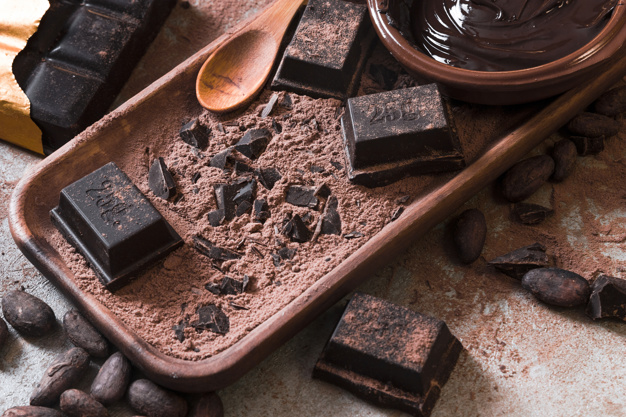
The warm and bitter drink did not immediately become famous among the colonial elite until the Spaniards added to the drink an ingredient that changed everything: sugar!
Fernand Cortez brought the bean and the recipe for cocoa with him and introduced it to the King of Spain Charles V in 1528. It is a success, the King adores and the xocolatl knows a craze throughout the Spanish court.
From Spain, cocoa invades all of Europe except for one country: France. Indeed, Louis XIV did not like cocoa, and out of the question to go against the tastes of the Sun King! It will be necessary to wait until the beginning of the 20th century for it to really reappear.
Until the 20th century, cocoa was reserved for the bourgeoisie because it was very expensive. It is consumed as a drink, but also as confectionery.
Anecdotally, the church was very wary of chocolate drinks, forbidden or at least not recommended in their religion, because known to be powerful aphrodisiac.
Today, cocoa is grown all over the planet: Central and South America of course, but also West Africa and Southeast Asia. 95% of the world’s cocoa production comes from family farming and small producers.
Among the species of the cocoa tree, the best is Criollo, which accounts for about 5% of world production. Except that to have the Criollo appellation, the tree must grow in Peru. If the same species grow elsewhere, as is the case with ours that grows in Cameroon, its beans are called “Native” beans.
Can I Grind Cacao Nibs Into Powder?
Cacao nibs can be an original ingredient to make your spreads, you can add it to your guacamole, Ktipiti, Muhammara, tzatziki, eggplant caviar, hummus, beet puree, tuna or sardine rillettes, broken pea spread, etc.
You can use it crushed to flavor all your sauces, gravy dishes, and simmered dishes.
Its flavor goes well with potatoes, pasta, candied tomatoes, beans, almond fish, or some seafood. Just crush them and add them at the end of cooking.
It’s excellent in drinks, you can use it to give flavor to your smoothies, milkshakes, hot chocolate, etc.
9 Key Benefits Of Cacao
All the properties discussed in this paragraph are equivalent to a consumption of 10 cocoa beans. Its virtues are optimal when they are raw as sold here, and not when they are roasted.
Antioxidant
Cocoa beans are very nutritious and invigorating. They contain a lot of natural healthy fats (50 %), fibers (15 %), proteins (12 %), and above all a remarkable content of polyphenols, with strong antioxidant properties.
The raw cocoa bean is an incredible source of antioxidants, from the family of flavonoids and polyphenols (epicatechin), equivalent to more than 10% of the weight of the seed! This is still much more than sencha green tea or even Goji berries.
These antioxidants improve the defenses against free radicals that attack and destroy cells and allow the prevention of many diseases: high cholesterol, cardiovascular diseases, diabetes, cancers, degeneration of neurons, arteriosclerosis, eye and vision diseases, Alzheimer’s, Parkinson’s, etc.
In short, it strengthens the vessels, promote circulation and protect cells from aging.
Increase Happiness
Cocoa is also rich in magnesium (anti-stress), theobromine (stimulant) and anandamide. Anandamide is a substance that creates a feeling of euphoria, which is also called the molecule of happiness. They increase the level of serotonin, the brain component of good mood.
All of these special nutrients will work together to bring you the wonderful chocolate feel on your palate and will also make you happy by increasing and stimulating the release of dopamine and serotonin in your brain. That’s why we love chocolate so much.
On the other hand, we have less of the fun and euphoric side that chocolate provides because there is no sugar.
Improves Sleep
Cocoa is a bean seed that contains more than 300 nutrients and active natural substances. Note its remarkable magnesium content, it is among the best dietary sources of magnesium: 500 mg of magnesium per 100 g of beans.
In addition, it is an excellent source of calcium, potassium, and phosphorus.
All this has many beneficial effects: balances the nervous system, and fights stress, anxiety, fatigue, and nervous and muscle tension. It improves sleep, concentration, and mood.
Reduce Pain And Boost Pleasure
Cacao is an excellent aphrodisiac that improves libido, thanks to phenethylamine which has the effect of releasing endorphins, compounds released during sexual intercourse.
In South America, it is often associated with maca Lepidium peruvianum and Muira Puama wood for greater effect.
Helps in Weight Loss
The cocoa seed, by its content of ferulic acid, has a role in the breakdown of lipids to release energy, which promotes weight loss. It would also have a satiating effect.
Good Source Of Energy
The theobromine contained in it has antitussive, diuretic, vasodilating and especially stimulating properties. Its tonic effect is slightly amplified by the presence of a small amount of caffeine.
It is therefore the ideal food for breakfast, in addition to being a good source of energy. Its physical, intellectual stimulating effect and its action on mood have long been recognized.
Prevent the Formation Of Blood Clots
Raw cocoa would be, like organic baobab powder, a natural aspirin. The Department of Nutrition at the University of California, Davis discovered that cocoa thins the blood and prevents the formation of blood clots. This discovery showed that eating raw cocoa is just as beneficial as taking an aspirin.
Rich in Various Vitamins
Raw cocoa is also recommended in pregnant women, because it is rich in vitamin B9, folic acid, vitamins A, B1, C, D and E, trace elements, and minerals. This has the effect of preventing certain diseases and malformations such as spina bifida or autism.
Rich in iron, the cocoa bean is ideal in case of anemia: 10g is enough to bring us our daily intake of iron.
Boost Intestinal health and immune System
As they are rich in fiber, cocoa beans allow an easier intestinal bowel movement.
It is also an ingredient rich in sulfur and zinc, perfect for the reconstruction of collagen, and keratin, and therefore on the shine and strength of hair, skin, and nails.
Incidentally, sulfur and zinc are beneficial for the liver and pancreas, cell health, blood sugar regulation, and for the immune system.
“cocoa bean is a phenomenon that nature has never repeated; We have never found so many qualities combined in such a small fruit.” Alexander von Humboldt
Nutritional values per 100 g :
– Calories: 520 Cal (2140 kJ)
– Fat (cocoa butter): 43 g
– Protein: 20 g
– Dietary fiber: 8.4 g
– Starch: 7 g
– Water: 5 g
– Mineral Substances: 6 g
– Cellulose: 4 g
– Theobromine: 2 g
– Carbohydrates: 1,3 g
Next, we will look at a few cocoa nibs and beans recipes you can prepare easily.
Although they are made to be eaten directly, either as a snack or as an aperitif, you can also cook your cocoa beans! We offer recipes with cocoa beans, from the easiest to the most original, to cook the best of this dried fruit. let yourself be guided, and embark on board Spice Island for a tour of the world of flavors!
How to properly choose cocoa beans and cacao nibs?
Raw cocoa beans have the advantage of better-preserving antioxidants, while those that have been roasted have a more pronounced cocoa flavor. “Each source offers specific flavors. It is interesting to taste two different ones and compare them.
Are there more popular varieties than others? Criollo is the rarest and most refined. But variety does not do everything. Still, it is necessary that the fermentation and drying have been well conducted to give a quality product.
Can I Substitute Cacao Nibs For Chocolate Chips?
Their raw flavor, not at all sweet and slightly bitter, can surprise. They are perfect to replace chocolate chips with your pancake batter, coffee, yogurt, smoothies, banana bread, and salad.
When crushed, cocoa beans and cacao nibs can be used in recipes as a spice that goes together with both salty and sweet. It can be sprinkled like large salt on a foie gras, game or even fish.
On the dessert side, they add crispness to a chocolate mousse, a banana cake, and small madeleines. As they are not sweet, we recommend adding blueberries or raspberries for extra sweetness.
Note: it is better to avoid consuming them in the evening, because of their stimulating effect and caffeine content.
Can I Use Dark Chocolate Instead Of Cacao Nibs?
Dark Chocolate is a healthy alternative that is good to replace the cacao nibs in cooking. It is rich in copper since 100 g of chocolate makes it possible to cover 22% of the recommended daily intake.
It is also rich in magnesium (112 mg per tablet) and iron. Dark chocolate is more bitter by nature and the taste may not the same as using cacao nibs. You can add more sugar or fruits to your recipe to sweeten it. You can add dark chocolate to cakes, muffins, or other desserts that also use cacao nibs.
By knowing more about the food you consume you ensure proper and optimal health for you and your family. I hope you enjoyed this lengthy post and the cacao nib recipes listed above.
8 Cacao Benefits
- Studies conducted on cocoa show that this “good mood” food is composed of many molecules with psychoactive properties. This would explain our drive towards chocolate, especially during moments of anxiety, stress, or fatigue.
- As the end of the Year celebrations approach, the shop windows of the chocolatiers are full of temptations and you have a hard time resisting… You are not the only one since 9 out of 10 French people admit to being addicted to chocolate.
- But, rest assured, even if your taste for chocolate resembles an addiction, according to expert nutritionists, one can not really talk about addiction, but more simply about “chocolatomania”!
- For scientists, what seems to explain our drive to chocolate in the event of a soft stroke or depression is that chocolate is composed of 500 different molecules, some of which have psychoactive properties: theobromine, caffeine, phenylethylamine, magnesium, serotonin…
- An experiment conducted on the animal illustrates this drive towards chocolate. Intravenous injection in dogs of phenylethylamine, one of the components of cocoa, stimulates its impulse for this molecule whose structure is close to those of amphetamines!
- We stock up on serotonin, the hormone of nice mood and happiness.
- Another neuromodulator, serotonin, present in cocoa has antidepressant effects. This same serotonin could also promote the reduction of appetite, hence the interest in maintaining chocolate in reasonable quantities in slimming diets.
- A study by the University of San Diego supports the idea that dark chocolate is good for the line, indicating that the slimming effect of chocolate would be related to the content of catechins, antioxidants that would promote weight loss and the fineness of muscles.
Finally, let’s not forget the taste pleasure that the consumption of chocolate provides, linked to the subtle tastes of different cocoa beans.


